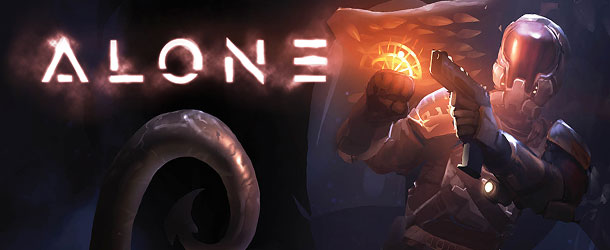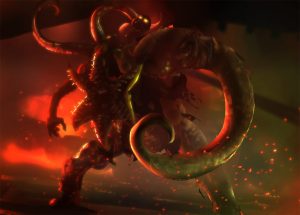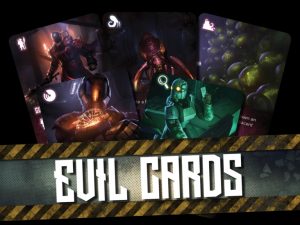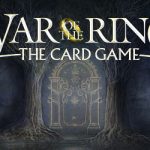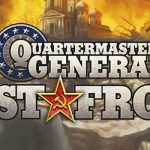Welcome back to Discovering Alone. Following the article about how the Hero plays in Alone, it’s now time to have a look at the gameplay for the one to three players who control the forces of Evil.
At the beginning of the game, the Evil players follow a mostly randomized procedure to generate a new map layout. This is so you will always have a different experience, even when replaying the exact same scenario. Each story chapter is narratively described in the scenario booklet, but gameplay-wise, most scenarios are composed of three kinds of cards: a Main Objective, a Bonus Mission, and an Ongoing Malus.
The Main Objective is the mission the Hero needs to complete to win the game. The other two missions are optional. If the Hero completes the Bonus Mission, he will gain some kind of permanent advantage for the rest of the game. The Ongoing Malus, instead, is a nuisance that is active from the beginning of the game. If the Hero completes it, the nuisance is permanently removed. Since they are the only ones allowed to look behind the screen, it’s the Evil players’ duty to setup and manage the missions.
Once the setup is completed and the game has started, it’s the Hero’s turn to become the absolute protagonist of the adventure. The Evil players will have to see what he does, plan a series of traps to stop him from completing his missions, and wait for the best moment to strike. They all play together towards a common goal: killing the Hero, or at the very least preventing him from completing his Main Objective.
The Evil players don’t have a proper turn, instead they React to the Hero’s Actions. They can Spawn Creatures, Move Creatures, Place Alert tokens, or Play Cards. They don’t have to spend Action points to pay for these: to pay the cost of a Reaction, they need to discard a certain number of cards. Creatures and Alert tokens are the main menaces the Evil players directly places on the map. Whenever placed or moved, they produce radar signals the Evil players must communicate to the Hero (who can use this info to deduce and avoid the Evil players’ plots). They are usually activated when the Hero enters an Unrevealed Sector containing some of these menaces, either because of his own recklessness, or a well-planned Evil bluff. To make things even more difficult, the Evil players can place fake Alerts, forcing the Hero to lose time to check all of them, or run through and take risks.
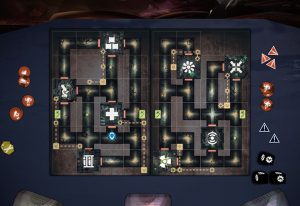
A randomized procedure is used to generate the map layout, for a different experience even when replaying the same scenario.
Cards, instead, are mainly used in response, and have a more “instant” use. They all have a Basic effect and a Bonus effect, triggered by some kind of requirement (like the presence of a Creature or an Alert token, or other environmental conditions). If particular requirements are fulfilled (and the Evil players still have enough cards to pay the extra costs involved), the cards can even be chained together to create a bigger combo with one single Reaction. A lot of careful planning is required to pull it off, and a bit of luck too, but when it happens it is a very satisfactory moment for the Evil players… not so much for the Hero, of course!
Each Evil player has a different personal deck; moreover, each deck is thematically different, changing its player’s overall gameplay style. For example, the Fury deck is specialized towards fighting and dealing a lot of HP damage; the Fear deck is all about sneak attacks and undermining the Hero’s Self-Control; and so on.
A different Evil player will be the Evil Leader during each one of the Hero’s turns. The Evil Leader has more cards in hand than his allies, so he’ll be able to play more than the others during that round, and he will also be making the calls when the Evil players disagree on the strategy to apply. Since the Evil card decks are different, each turn will be played slightly differently, depending on which deck is used by the Leader. This has two advantages: even if their game is fully cooperative, each Evil player will still feel unique and special; it will also force the Hero to plan his moves differently, each round. It may be better to avoid a fight, when the Fury player is in charge!
The Hero does not have an easy life in Alone, but the Evil players have their own challenges as well. They can’t just play everything they want, whenever or wherever they like. They are not only limited to one Reaction at a time; the Hero can also prevent them from doing so thanks to its Adrenaline. Their hand of cards is limited, and without cards, they can’t React anymore; finally, the Creatures and Alerts general pool is limited too (they can’t be replaced when they are killed or removed), and only a certain number of them can be present on the map at the same time. Evil players need to be careful with their resources, just like the Hero.
The next – and final – article of Discovering Alone will focus on the game’s artwork in a chat with the illustrator Steve Hamilton.
Previous articles: Game Overview, The World of Alone, Designers' Diary, Hero Gameplay.
Next article: The Art of Alone
* "Discovering Alone" articles were originally published during the first game's Kickstarter project, by Horrible Guild's team.

